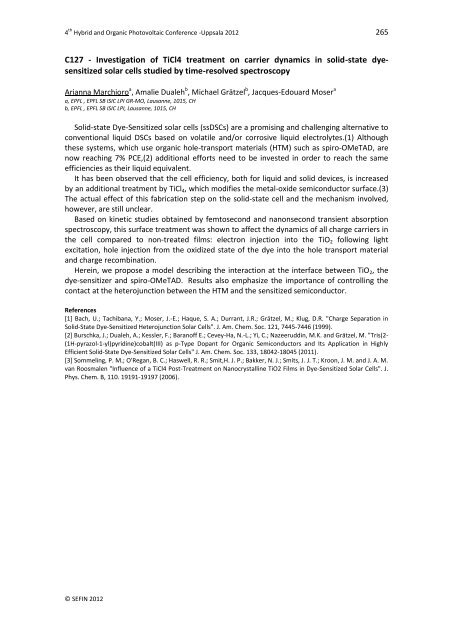HOPV12 - Blogs
HOPV12 - Blogs
HOPV12 - Blogs
You also want an ePaper? Increase the reach of your titles
YUMPU automatically turns print PDFs into web optimized ePapers that Google loves.
4 th Hybrid and Organic Photovoltaic Conference -Uppsala 2012 265<br />
C127 - Investigation of TiCl4 treatment on carrier dynamics in solid-state dyesensitized<br />
solar cells studied by time-resolved spectroscopy<br />
Arianna Marchioro a , Amalie Dualeh b , Michael Grätzel b , Jacques-Edouard Moser a<br />
a, EPFL , EPFL SB ISIC LPI GR-MO, Lausanne, 1015, CH<br />
b, EPFL , EPFL SB ISIC LPI, Lausanne, 1015, CH<br />
Solid-state Dye-Sensitized solar cells (ssDSCs) are a promising and challenging alternative to<br />
conventional liquid DSCs based on volatile and/or corrosive liquid electrolytes.(1) Although<br />
these systems, which use organic hole-transport materials (HTM) such as spiro-OMeTAD, are<br />
now reaching 7% PCE,(2) additional efforts need to be invested in order to reach the same<br />
efficiencies as their liquid equivalent.<br />
It has been observed that the cell efficiency, both for liquid and solid devices, is increased<br />
by an additional treatment by TiCl4, which modifies the metal-oxide semiconductor surface.(3)<br />
The actual effect of this fabrication step on the solid-state cell and the mechanism involved,<br />
however, are still unclear.<br />
Based on kinetic studies obtained by femtosecond and nanonsecond transient absorption<br />
spectroscopy, this surface treatment was shown to affect the dynamics of all charge carriers in<br />
the cell compared to non-treated films: electron injection into the TiO2 following light<br />
excitation, hole injection from the oxidized state of the dye into the hole transport material<br />
and charge recombination.<br />
Herein, we propose a model describing the interaction at the interface between TiO2, the<br />
dye-sensitizer and spiro-OMeTAD. Results also emphasize the importance of controlling the<br />
contact at the heterojunction between the HTM and the sensitized semiconductor.<br />
References<br />
[1] Bach, U.; Tachibana, Y.; Moser, J.-E.; Haque, S. A.; Durrant, J.R.; Grätzel, M.; Klug, D.R. "Charge Separation in<br />
Solid-State Dye-Sensitized Heterojunction Solar Cells". J. Am. Chem. Soc. 121, 7445-7446 (1999).<br />
[2] Burschka, J.; Dualeh, A.; Kessler, F.; Baranoff E.; Cevey-Ha, N.-L.; Yi, C.; Nazeeruddin, M.K. and Grätzel, M. "Tris(2-<br />
(1H-pyrazol-1-yl)pyridine)cobalt(III) as p-Type Dopant for Organic Semiconductors and Its Application in Highly<br />
Efficient Solid-State Dye-Sensitized Solar Cells" J. Am. Chem. Soc. 133, 18042-18045 (2011).<br />
[3] Sommeling, P. M.; O'Regan, B. C.; Haswell, R. R.; Smit,H. J. P.; Bakker, N. J.; Smits, J. J. T.; Kroon, J. M. and J. A. M.<br />
van Roosmalen "Influence of a TiCl4 Post-Treatment on Nanocrystalline TiO2 Films in Dye-Sensitized Solar Cells". J.<br />
Phys. Chem. B, 110. 19191-19197 (2006).<br />
© SEFIN 2012


